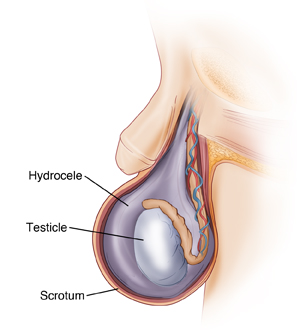Hydrocele Surgery (Hydrocelectomy)
A hydrocele is a sac of fluid that forms around a testicle. It occurs when fluid builds up in the layer of tissue that covers the testicle. It may be caused by an infection or by injury to the testicle. But the cause is often not known. A large hydrocele can cause pain or swelling in the scrotum. Hydrocelectomy is surgery to remove the hydrocele.

Getting ready for surgery
Prepare for the surgery as you have been told. In addition:
-
Tell your healthcare provider about all medicines you take. This includes both prescription and over-the-counter medicines. This also includes vitamins, herbs, and other supplements. It also includes any blood thinners, such as warfarin, clopidogrel, or daily aspirin. You may need to stop taking some or all of them before surgery as instructed by your provider.
-
Follow any directions you are given for not eating or drinking before surgery.
The day of surgery
The procedure takes about 30 minutes. You will likely go home the same day.
Before the surgery
-
An IV (intravenous) line is put into a vein in your arm or hand. This line delivers fluids and medicine (such as antibiotics).
-
You are then given medicine (anesthesia) to keep you pain-free during the surgery. This may be general anesthesia, which puts you in a deep sleep-like state through the surgery. A tube may be put into your throat to help you breathe.
-
Local anesthesia or numbing medicine may be given to help control post-surgery pain. Your healthcare provider, anesthesiologist, or nurse anesthetist can tell you more.
During the surgery
-
A cut (incision) is made in the scrotum.
-
The hydrocele is drained of fluid. The tissue that forms the sac around the hydrocele is removed or repositioned. This helps prevent fluid from building up again.
-
A thin tube (drain) may be placed in the incision to let fluid drain. This tube is taken out a few days later in the office.
-
The incision in the scrotum is closed with stitches or surgical strips.
After the surgery
You will be taken to the post anesthesia care unit (PACU) as you wake up from the anesthesia. A nurse will closely monitor your vital signs. They will also give you medicine for pain if needed. You may feel sleepy and nauseated. If a breathing tube was used, your throat may be sore at first. An ice pack may be put on the surgical area. This helps reduce swelling. You may also be given a jockstrap to wear. This helps ease pain and swelling, and prevents injury. Once you are ready to go home, have an adult family member or friend drive you.
Recovering at home
Follow the instructions you have been given to care for yourself. During your recovery:
-
Put an ice pack or cold compress on the scrotum as directed to help reduce swelling. Do this for no longer than 15 minutes at a time. To make an ice pack, put ice cubes in a plastic bag that seals at the top. Wrap the bag in a clean, thin towel or cloth. Never put ice or an ice pack right on the skin. Continue using the cold pack for 2 days or until swelling improves.
-
Take prescribed pain medicine as directed.
-
Care for your incision as instructed.
-
Follow your healthcare provider’s guidelines for showering. Don't swim, bathe, use a hot tub, or do other things that will cover the incision with water until your provider says it’s OK.
-
Wear a jockstrap or snug underwear as directed.
-
Don't lift anything heavy. Exercise as directed.
-
Don't have sex for 4 weeks, or as directed.
-
Don't drive until you are no longer taking pain medicine and your provider says it’s OK.
When to call your healthcare provider
Call your healthcare provider right away if you have any of the following:
-
Fever of 100.4° F ( 38°C ) or higher, or as directed by your healthcare provider
-
Symptoms of infection at the incision site such as:
-
More redness or swelling
-
Warmth
-
Pain that gets worse
-
Bad-smelling drainage
-
Bleeding from the incision site
-
Pain that gets worse or is not eased by pain medicine
-
More pain or swelling in the scrotum or groin area
Call 911
Call 911 right away if you have:
-
Chest pain
-
Trouble breathing
Follow-up care
You will have follow-up visits with your healthcare provider to check on your healing. You may also have stitches or a surgical drain that needs to be removed. Be sure to tell your provider if you have any questions or concerns about your recovery.
Risks and possible complications
All procedures have risks. Possible risks of this procedure include:
-
Bleeding
-
Infection
-
Blood clots
-
The hydrocele comes back
-
Injury to the testicle and nearby structures, which can lead to infertility
-
Risks of anesthesia (the anesthesiologist or nurse anesthetist will talk about these with you)
Online Medical Reviewer:
Marc Greenstein MD
Online Medical Reviewer:
Raymond Kent Turley BSN MSN RN
Online Medical Reviewer:
Rita Sather RN
Date Last Reviewed:
12/1/2022
© 2000-2024 The StayWell Company, LLC. All rights reserved. This information is not intended as a substitute for professional medical care. Always follow your healthcare professional's instructions.